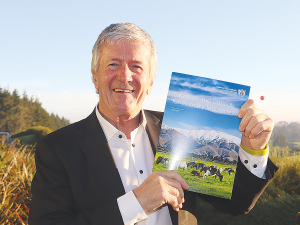NZ food & fibre exports to reach record $62b by 2026
New Zealand's primary sector is set to reach a record $62 billion in food and fibre exports next year.
 Agriculture Minister Damien O’Connor with the Ministry for Primary Industries’ latest Situation and Outlook for Primary Industries (SOPI) report at National Fieldays this month.
Agriculture Minister Damien O’Connor with the Ministry for Primary Industries’ latest Situation and Outlook for Primary Industries (SOPI) report at National Fieldays this month.
For the much-maligned dairy industry, NZ's primary export returns for 2023 would be looking grim.
That's the conclusion one can draw from the Ministry for Primary Industries' latest Situation and Outlook for Primary Industries (SOPI) report, released before a group of industry leaders at the Fieldays. The report shows that earnings from the dairy sector were $25.1 billion - double that of the meat and wool sector and more than three times that of horticulture.
The total revenue from the primary sector for 2023 was a record $56.2 billion - nearly $3 billion more than last year. The very good news is that dairy exports are predicted to reach $28.2 billion by 2027, while export growth for meat and wool will remain static for the next four years and is unlikely to reach the $12.3 billion it was in 2022.
The section in the SOPI report on dairying notes that China is easily NZ's single biggest market for dairy products, taking 34% of our exports. Indonesia at 6% is the next biggest market with Australia third at just 5%. China is the biggest market for all our dairy products except casein and products which is snared by the US.
According to the SOPI report, the performance by the dairy sector is excellent, especially considering the challenges and uncertainties it has faced due to Covid-19 in China. But there are also warning signs in the report with commentary on the fact that global dairy prices are in decline, although they remain above average. It notes that demand for dairy has weakened due to a slowdown in global economic growth, rising inflation and high food prices.
It also points to better supply coming onto the world market from the EU and the US in the past season, but goes on to suggest that milk production in these countries has now slowed and will likely prevent any crash in dairy prices.
There is recognition in the SOPI report of high farm input costs affecting on-farm profitability in NZ, but it says that the staff shortages in the sector are easing and, as most of us have seen, pasture grown in the past few months has been excellent.
Overall, the SOPI report paints a picture of a good 2023 year, but that growth in the coming few years will be incremental rather than spectacular. Horticulture will go through something of a rebuilding phase to get volumes of kiwifruit and apples up, while meat and wool remains a challenge.
Legal controls on the movement of fruits and vegetables are now in place in Auckland’s Mt Roskill suburb, says Biosecurity New Zealand Commissioner North Mike Inglis.
Arable growers worried that some weeds in their crops may have developed herbicide resistance can now get the suspected plants tested for free.
Fruit growers and exporters are worried following the discovery of a male Queensland fruit fly in Auckland this week.
Dairy prices have jumped in the overnight Global Dairy Trade (GDT) auction, breaking a five-month negative streak.
Alliance Group chief executive Willie Wiese is leaving the company after three years in the role.
A booklet produced in 2025 by the Rotoiti 15 trust, Department of Conservation and Scion – now part of the Bioeconomy Science Institute – aims to help people identify insect pests and diseases.
President Donald Trump’s decision to impose tariffs on imports into the US is doing good things for global trade, according…
Seen a giant cheese roll rolling along Southland’s roads?